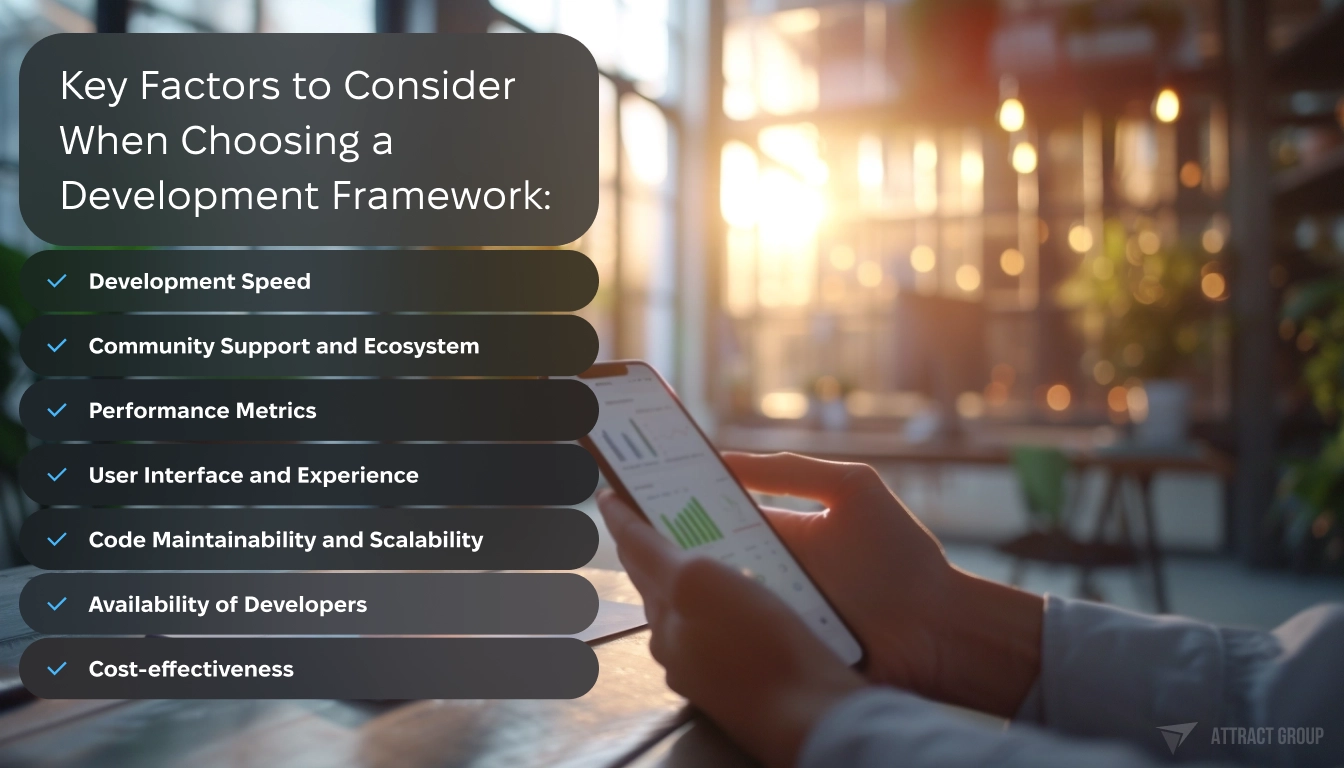🔊 Listen to the Summary of this article in Audio
In a market densely populated with technologies, the choice between Flutter and React Native is a pivotal decision for entrepreneurs aiming to develop cross-platform mobile applications. Both frameworks have become the cornerstone of modern app development, with Google’s Flutter and Meta’s React Native leading the fray. This comparison between Flutter and React Native is not just about assessing two technologies — it’s a critical business choice that could define the operational efficiency and market success of a mobile app.
When analyzing Flutter vs React Native, it is essential to consider the free and open-source legacy these frameworks carry forward. Flutter, with its 2018 inception, offers a reactive UI through Dart, while React Native has capitalized on JavaScript since its 2015 release by Meta. The nuances of each framework — such as development tools, language preference, community support, and performance metrics — collectively act as the determining factors for businesses as they grapple with the challenge of delivering seamless user experiences across various platforms.

Entrepreneurs embarking on the app development journey must make an informed decision that aligns with their strategic goals, budget considerations, and user engagement objectives. This examination into mobile app development and framework comparison for business is a testament to the dynamic landscape of cross-platform technologies. The outcome of this selection can majorly influence an app’s performance, agility, and long-term viability in an ever-competitive digital ecosystem.
Key Takeaways
- Understanding the nuances and strengths of each framework can help in making an informed decision for cross-platform mobile app development.
- Flutter’s use of Dart and custom widget suite offers a high degree of customization, whereas React Native’s JavaScript base appeals to a wide range of developers.
- The choice between Flutter and React Native affects not just the user experience but also factors such as development speed, code maintainability, and market reach.
- React Native’s mature ecosystem and wide adoption contrast with Flutter’s rapidly growing community and cohesive design language.
- Businesses should weigh their technical requirements and project scope against each framework’s capabilities for a strategic fit.
Introduction to Cross-Platform Mobile Development
The advent of cross-platform app development has ushered in a transformative era for mobile developers and entrepreneurs alike. Frameworks such as Flutter and React Native have become the harbingers of change, championing the cause of efficiency, cost-effectiveness, and an enhanced user experience. By allowing the use of a singular codebase to deploy applications across multiple platforms, these tools have greatly simplified the once cumbersome task of native app development.
In the past, the journey from conception to market for a mobile app was fraught with complexity. Developers needed to be versed in multiple programming languages and specialized development tools for iOS and Android, which escalated costs and extended development timelines. This divided approach also complicated the task of maintaining parity between the various app versions, especially when it came to performance and feature updates.
Today, however, the landscape is markedly different. Cross-platform solutions are not just cutting down development speed significantly but are also delivering a user experience that rivals that of native apps. With frameworks like Flutter and React Native, businesses are now in a position where they can rapidly address a broader audience, thanks to the ability to launch on multiple platforms simultaneously with a consistency in function and design.
Leveraging the power of Dart and JavaScript, the respective programming languages of Flutter and React Native, developers can bring to life applications that feel intuitive and run seamlessly on a variety of devices. This not only reduces the time-to-market but also allows for a more agile development process, where the turn-around time for implementing and testing new features is reduced substantially.
The table below illustrates a simplified comparison between the approaches of traditional native development and modern cross-platform app development, highlighting their impact on development speed and user experience.
| Development Approach | Programming Languages Needed | Development Speed | User Experience Consistency |
|---|---|---|---|
| Traditional Native | Objective-C/Swift (iOS), Java/Kotlin (Android) | Slow (Separate codebases) | High (But inconsistent across platforms) |
| Cross-Platform | Dart (Flutter), JavaScript (React Native) | Fast (Single codebase) | High (Consistency maintained) |
In conclusion, the potent combination of a single framework, a shared programming language, and an accelerated development process has made cross-platform app development an attractive proposition for businesses aiming to establish a strong foothold in the mobile app domain.
Get a free consultation from our experts on the best cross-platform solution for your business needs
Understanding Flutter and React Native
In the arena of cross-platform development, two frameworks have made significant strides — Flutter and React Native. Understanding Flutter and React Native is key for entrepreneurs, developers, and businesses as they can significantly reduce the development time and effort required to build mobile, web, and desktop applications. This section offers an insight into what they are, their unique advantages, and how they compare with one another in the technological ecosystem.

What is Flutter?
Flutter is a UI toolkit developed by Google for crafting natively compiled applications from a single codebase. Released in December 2018, its rich set of customizable widgets and native performance have quickly gained traction among developers. Those enamored with mobile, web, and desktop development look to Flutter when they need a powerhouse of creativity and efficiency. What sets Flutter apart is its use of the Dart programming language and its own rendering engine, which bypasses the need for OEM widgets and allows for high-performance, beautiful UI designs that are consistent across all platforms.
What is React Native?
Meta’s contribution to the cross-platform dialogue comes in the form of React Native, a framework that revolutionized the industry with its 2015 release. It allows development using JavaScript — one of the most widely used programming languages. React Native appeals to a broad developer base by providing the means to create apps that are not only mobile-friendly but also provide a user experience almost indistinguishable from native apps. It does this by leveraging the native UI building blocks of iOS and Android, which contributes to its reputation as a go-to solution for mobile app development that resonates with familiarity and ease for the end user.
To compare React Native and Flutter is to look at two of the industry’s most fervent solutions to cross-platform development. As we navigate the intricacies of mobile, web, and desktop development with these tools, we are witnessing a transformation in how apps are envisioned, created, and delivered to a diverse audience.
Key Factors to Consider When Choosing a Development Framework
The tech landscape today presents an array of frameworks for entrepreneurs to choose from, each promising to deliver the best in cross-platform app development. Selecting a development framework is influenced by numerous considerations that range from purely technical to strategic business decisions. Identifying the right fit involves a deep dive into factors like development speed, community support, and the all-important cost-effectiveness to ensure optimal use of resources.
Development Speed
For businesses looking to hit the market quickly, development speed is a significant factor. The fast-paced nature of technology and user demand puts pressure on enterprises to deploy apps promptly. React Native’s use of JavaScript can expedite the development process, particularly when the design needs differentiate between Android and iOS platforms. Consequently, React Native could lead to quicker market entry in certain project scopes.
Community Support and Ecosystem
A robust support network is indispensable for solving development challenges and learning from the shared experiences of a global community. While both Flutter and React Native boast strong ecosystems, React Native has a broader community owing to its earlier marketplace entry. This extended network can be a decisive resource when encountering unique development hurdles or exploring new features to enhance your app.
Performance Metrics: Flutter vs React Native Performance
Performance is the backbone of user satisfaction. Flutter and React Native both feature hot reload capabilities, streamlining the trial and error process in app development. However, Flutter is noted for its clear documentation, contributing to its reliability and predictability in performance metrics. It is vital to gauge each framework’s performance nuances, including runtime efficiency and response time, to match your app’s intended functionality.
User Interface and Experience
The charm of any application lies in its user interface and the overall user experience it delivers. Flutter’s extensive suite of widgets allows for vibrant and versatile UI designs, enhancing the visual aspect of apps across different platforms. React Native, on the other hand, offers the use of native components that can contribute to a seamless user journey. The interface approach chosen must resonate with the target audience to foster engagement and retention.
Code Maintainability and Scalability
Codebase longevity is an aspect often overlooked at the onset of development. Frameworks must not only cater to current requirements but also adapt to future expansions and iterations. Both Flutter and React Native advocate for code maintainability and scalability, which are key to evolving with market trends and user demands without the need for extensive overhauls.
Availability of Developers
The pool of developers available for a given framework can influence decision-making. Dart, the language underpinning Flutter, may have a smaller developer base compared to the vast array of developers proficient in JavaScript for React Native. Aligning with a framework with more readily available talent can streamline recruitment and accelerate app development.
Cost-effectiveness
In the business realm, the bottom line is a critical measure of any strategic decision, and choosing a development framework is no exception. The cumulative costs of app development, which encompass initial outlay, long-term maintenance, and any requisite training or hiring, must be weighed to determine the most cost-effective path forward. On this front, the total cost of ownership over the app’s lifecycle should guide the framework selection process.
Each of these considerations plays a pivotal role in determining which framework — Flutter or React Native — stands as the optimal choice for your project. Balancing these factors against the unique needs of your business and the expectations of your end-users will guide you to a strategic and impactful selection.
Our team can help build and deploy your app using Flutter or React Native to reduce time-to-market
Detailed Comparison Between Flutter and React Native
Choosing the right framework for cross-platform app development is critical for the success of the project. This detailed comparison examines the intricacies of Flutter and React Native, providing insights into each framework’s characteristics, ranging from the programming languages they use to their adoption in the marketplace.

Programming Language: Dart vs JavaScript
Dart and JavaScript are the lifeblood of Flutter and React Native, respectively. Dart is lauded for its ability to compile to native code, offering a significant performance boost. JavaScript is renowned for its widespread use, making it a familiar choice for a wide contingent of developers.
Architecture and State Management
Underneath the application layer, the architecture and state management dictate how data flows within an app. Flutter favors the reactive programming model that is responsive and scalable, while React Native benefits from the popular Flux architecture that promotes unidirectional data flow and offers predictability in state management.
Development Tools and Documentation
Robust development tools and comprehensive documentation can accelerate the app development process. Flutter distinguishes itself with meticulous, orderly documentation and automated tools which aid in easier adoption and scalability. React Native, backed by a substantial community, offers a plethora of shared knowledge and third-party tools, although it may not match Flutter’s well-organized documentation.
Integration with Native Components
Effective integration with native components is key to ensuring a seamless user experience. Flutter provides a suite of widgets that can be tailored to mimic native components, while React Native uses bridging to leverage the native UI building blocks directly.
Testing and Debugging Capabilities
Flutter’s widget-rich framework simplifies the process of testing, providing a reliable environment to test user interfaces. React Native, harnessing the power of JavaScript, provides a dynamic environment to debug codes more effectively with the help of its vast array of development tools.
Deployment and Continuous Integration/Continuous Delivery (CI/CD)
CI/CD practices are critical for rapid and consistent delivery of applications. Both Flutter and React Native support CI/CD, though the choice between fastlane, Codemagic for Flutter, or popular services like Travis or Jenkins for React Native might affect the implementation strategy.
App Size: Flutter vs React Native App Size
The size of the application can influence download times and user engagement. Flutter’s extensive widgets might increase the app size, while React Native tends to produce smaller application binaries, which could be a critical factor depending on the application’s target market and distribution channels.
Popularity and Market Adoption
Market trends are an important consideration, as they can indicate the direction of ongoing development and support. While React Native currently enjoys greater popularity due to its longer presence in the industry, the market adoption of Flutter is rapidly increasing, signaling a growing preference for Google’s SDK in the development community.
Case Studies: Real-world Applications of Flutter and React Native
In the evolving sphere of mobile app development, Flutter and React Native stand out as two frameworks that have not only garnered attention but also demonstrated substantial success through real-world applications. These case studies embody the frameworks’ capacities to create robust, function-rich, and user-centric apps. Here, we explore notable success stories that underscore the practicality and impact of Flutter and React Native across various sectors and platforms.
Success Stories Using Flutter
Flutter’s rise to prominence is marked by its adoption in creating several renowned applications. Its widget-centric approach enabled Google Ads to offer a reactive interface and powerful features on mobile devices, while Xianyu by Alibaba scaled across millions of users with its seamless experience. Yet another testament to Flutter’s prowess is the Hamilton app. All these applications share a common thread — high-performance and visually attractive designs that remain consistent, underscoring Flutter’s capabilities in catering to diverse audiences.

Success Stories Using React Native
React Native, leveraging the widely-used JavaScript, has facilitated the development of applications that emphasize a native look and feel. Facebook and Instagram — two of the largest social networks — have reached millions of daily active users, showcasing the high performance and seamless integration React Native promises. Airbnb was yet another success story, albeit partially developed with React Native, which displayed the framework’s strengths in a dynamic marketplace. From speedy performance to vast reach, React Native’s real-world applications provide a blueprint for success across the spectrum of mobile app development.
- Google Ads – A paradigm of Flutter’s smooth user experience and performance across multiple functionalities
- Xianyu by Alibaba – Flutter enables this app to maintain a consistent user experience despite heavy user traffic
- Hamilton – Leveraging Flutter led to an app that allows users to engage with the world of Broadway in unique and interactive ways
- Facebook – A React Native success story illustrating the framework’s ability to handle enormous social media traffic while maintaining user experience
- Instagram – React Native facilitated deployment of new features rapidly across platforms, maintaining a homogenous brand experience
- Airbnb – Demonstrating React Native’s capacity for enhancing an international platform with a broad and varied set of features
The success stories of Flutter and React Native serve as powerful indicators of the frameworks’ potential to revolutionize the mobile app development landscape. Case studies of these real-world applications are not just narratives of triumph but also insightful data points guiding future development strategies and decisions.
Work with our experts to develop an engaging, high-performance app tailored to your business needs
Which is Easier: Flutter or React Native?
When discussing which is easier, Flutter or React Native, one must consider developer experience with the frameworks’ respective languages: Dart and JavaScript. For individuals with a background in JavaScript, React Native may present a less steep learning curve due to its use of a familiar language and extensive support in the developer community. Conversely, Flutter might require a modest adjustment phase for those new to Dart, but it compensates with exceptional, thorough documentation that eases the ease of use.
The journey to mastering a new technology is about more than syntax familiarity; the broader developer experience, including the availability of learning resources, community support, and practical ease of adoption, all contribute to the overall difficulty level. Below is a comparative analysis that illustrates these points more concretely for both frameworks.
| Framework | Programming Language | Ease of Learning for Newcomers | Availability of Learning Resources | Community Support |
|---|---|---|---|---|
| Flutter | Dart | Smooth with comprehensive documentation | Rich set of official and third-party tutorials | Growing rapidly, with Google’s strong backing |
| React Native | JavaScript | Immediate for JavaScript developers | Extensive, owing to JavaScript’s popularity | Very large, with widespread industry use |
“The right framework is not necessarily the easiest; it’s the one that aligns best with the team’s skills and the project’s requirements.”
In essence, the decision of which is easier, Flutter or React Native, is not one-size-fits-all. It requires a nuanced approach that takes into account personal or team familiarity with the programming language, the scope of project requirements, and the value placed on community and documentation support. Weighing these factors will guide the right choice for an enjoyable and efficient development process.
Get a free consultation on building an effective loyalty program catered to your retail business
Making the Right Choice for Your Business
Embarking on the development of a cross-platform application is an intricate journey where every decision can significantly influence a project’s success. Making the right framework choice is a vital step, deeply tied to a business’s operational goals and market vision. The framework you choose today must stand the test of time, adapting to both technological shifts and evolving user expectations. Here’s how businesses can lay a future-oriented foundation by carefully selecting their app development framework.
Analyzing Business Requirements
Business requirements analysis is the keystone in the process of selecting a cross-platform mobile development framework. This involves a strategic evaluation of several critical factors:
- Target platforms: iOS, Android, web, desktop
- Desired features: Multimedia support, GPS, third-party integrations
- User base expectations: Intuitive UI/UX, performance benchmarks
- Development resources: Available expertise, community support
- Budget constraints and timelines for deployment
When these requirements are mapped out with precision, entrepreneurs can narrow down their options and gravitate towards a framework that promises compatibility and efficiency.

Future-Proofing Your App Development
Future-proofing app development encompasses more than simply riding the latest technology wave; it’s about building sustainability and flexibility into your application’s very framework. Choosing a platform that continually embraces innovation and aligns with the digital trajectory is crucial. Factors to consider include:
- The adaptability of the framework to new and emerging technologies
- The framework’s roadmap for incorporating novel features or standards
- The compatibility of the framework with various hardware and operating systems as they evolve
Ensuring your platform is on a path of progressive enhancement guarantees that your product remains relevant and competitive, providing long-term value to users and the business alike.
Considering the Long-Term Support and Updates
Long-term support is the lifeline of any app’s durability in the market. Selecting a framework with a reputation for consistent updates and developer support is essential for the continuity and resilience of mobile applications. A strong community and corporate backing often indicate a framework’s commitment to growth and reliability.
- Review the update history and frequency of the frameworks
- Assess the availability and responsiveness of the developer community
- Consider the backing entities and their investment in the framework’s future
Proper assessment ensures an informed choice, mitigating the risk of future obsolescence and reinforcing the app’s potential to adapt to an ever-evolving tech landscape.
In conclusion, a methodical approach to selecting a cross-platform app development framework, rooted in comprehensive business requirements analysis, anticipatory future-proofing, and assured long-term framework support, can set a solid foundation for lasting mobile application success. By thoroughly weighing these considerations, your business can make a discerning technology choice that yields a robust, responsive, and enduring mobile presence.
Conclusion: Summarizing Flutter vs React Native
In synthesizing the discussion on the merits of Flutter vs React Native for cross-platform app development, it is evident that both frameworks bring distinctive strengths to the table. Summarizing the comparative analysis, we see Flutter, with its custom widgets and performance, rapidly ascending in popularity and firmly establishing itself as a strong choice for businesses embarking on new projects. Its framework selection is often praised for the high degree of design customization it permits and its impressive performance metrics.
React Native, with its deep roots in the mature ecosystem of JavaScript, continues to be a bastion of reliability, renowned for its extensive community support. Its framework has earned the trust of developers over time, and its ability to leverage a vast array of JavaScript libraries makes it a sound decision for many cross-platform app development endeavors.
The dilemma of framework selection ultimately boils down to the business’s unique needs and the development team’s preferences. To aid in this decision-making process, consider the following comparative table that encapsulates key aspects of both Flutter and React Native:
| Framework | Unique Selling Point | Programming Language | Widget/Component Approach | Community Support | Recommended For |
|---|---|---|---|---|---|
| Flutter | Highly customizable UI with native performance | Dart | Rich set of proprietary widgets | Expanding quickly with Google’s support | Projects with a need for bespoke design and rapid UI iteration |
| React Native | Mature ecosystem with JavaScript foundations | JavaScript | Native component framework | Extensive, well-established, and widespread | Apps that require a broad community for library and troubleshooting resources |
In conclusion, both Flutter and React Native are poised to address the growing demand for cross-platform applications. Each comes with its arsenal of features and a unique approach to unifying the app development process across diverse operating systems. Depending on whether the prioritization is on innovation in UI/UX design, developer convenience, or performance, these frameworks present viable alternatives for entrepreneurs seeking to make a mark in the digital ecosystem.
“Whether you choose Flutter or React Native, the goal remains the same — to create an engaging and efficient app experience for users across all platforms.”
Leverage our expertise in Flutter and React Native to build, launch and scale your application
FAQ
What is Flutter?
Flutter is a UI toolkit created by Google designed to develop natively compiled applications for mobile, web, and desktop from a single codebase. It is known for its rich set of customizable widgets and its own rendering engine.
What is React Native?
React Native is an open-source mobile application framework developed by Meta that enables developers to build mobile apps using JavaScript. It uses native UI building blocks to create high-quality apps for iOS and Android platforms.
Which factors should be considered when choosing a development framework?
When selecting a development framework, you should evaluate development speed, community support and ecosystem, performance, user interface, and experience, code maintainability and scalability, availability of skilled developers, and cost-effectiveness.
What are the differences in programming language between Flutter and React Native?
Flutter uses Dart as its programming language, which is known for compiling to native code, leading to high performance. React Native uses JavaScript, a widely-adopted language that allows for flexibility and quicker development cycles.
How do Flutter and React Native differ in architecture?
Flutter is built with a reactive programming model and has its own set of widgets, while React Native is based on the Flux architecture and uses native UI components, which helps to provide a near-native user experience.
Can you compare Flutter vs React Native in terms of development tools and documentation?
Flutter’s development tools and documentation are praised for being comprehensive and well-organized, which can speed up the development process. React Native, while also supported by a range of development tools, benefits from a large community that contributes to its resources and documentation.
How do the frameworks integrate with native components?
Flutter has its own widgets but also offers ways to integrate with native code if needed. React Native runs on JavaScript, but directly uses native components from iOS and Android, allowing parts of the app to be written in native code.
What are the testing and debugging capabilities of Flutter and React Native?
Flutter provides a robust testing framework with a wide variety of widgets to test UI, functionality, and performance. React Native offers several debugging tools and can leverage the extensive JavaScript toolset for testing and debugging.
How do app sizes compare in Flutter vs React Native?
Generally, Flutter apps can be larger in size due to the inclusion of the Dart runtime and the app’s compiled libraries. React Native apps may have smaller sizes because they rely on the device’s existing JavaScript engines and native components.
Which framework has greater popularity and market adoption?
React Native has been around longer and therefore has a larger user base and more mainstream recognition. However, Flutter has been gaining popularity rapidly due to its performance and ease of development.
Why choose Flutter over React Native?
Choose Flutter if you require a powerful UI toolkit with a rich widget library, desire a customized design across multiple platforms, and prefer the performance benefits of Dart’s compilation to native code.
Why choose React Native over Flutter?
Opt for React Native if you need to leverage a vast community, want the potential for live updates without app store submissions, value the ability to write some components with native code, and are comfortable with the established practices and longevity of the framework.
How does the choice of framework affect hiring?
The choice of framework affects hiring because it dictates the skill set required from the developers. For Flutter, you’ll need developers skilled in Dart, whereas React Native requires developers who are proficient in JavaScript.
What are the limitations of each framework?
Flutter’s limitations include a relatively smaller community compared to React Native, potentially larger app sizes, and the need for developers to learn Dart. React Native may face challenges with performance in complex applications and sometimes requires additional work to optimize for each platform.









